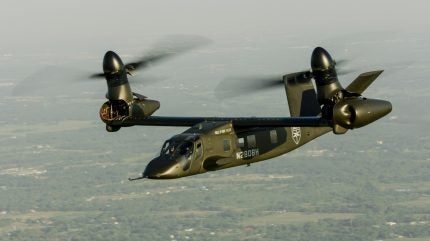
QinetiQ US has been selected by Integris Composites to contribute its systems engineering and integration capabilities to the US Army’s Future Long Range Assault Aircraft (FLRAA) programme.
The company will be using its LAST Armor Integration solution to support the programme.
The LAST Armor solution is a lightweight, high-performance ballistic protection system designed for both fixed wing and rotary wing platforms.
First introduced during Operation Desert Storm in 1991, the armour has since been deployed across more than 40 aircraft types in 16 allied countries worldwide.
It is deployed by the US military, international allies, commercial aircraft manufacturers, and law enforcement agencies.
The company produces LAST Armor at its Franklin facility in Massachusetts, USA.

US Tariffs are shifting - will you react or anticipate?
Don’t let policy changes catch you off guard. Stay proactive with real-time data and expert analysis.
By GlobalDataQinetiQ US Advanced Robotics and Mission Solutions executive vice president Christopher Forrest said: “QinetiQ US is honoured to partner with Integris Composites, a long-time supplier partner, to deliver a tailored armoured survivability solution for the US Army’s Future Vertical Lift programme.
“Utilising high performance fibres and advanced ceramics, LAST Armor solutions offer proven traditional ballistic protection for mission success.”
Integris Composites was selected in November 2024 by Bell Textron as a supplier of armour systems for the FLRAA.
The FLRAA Weapon System Development contract, awarded to Bell Textron in December 2022, includes nine options. It involves the development of a FLRAA prototype of Bell’s V-280 demonstrator aircraft.
In August 2024, the US Army approved the Milestone B decision, transitioning the FLRAA into the engineering and manufacturing development phase. This phase will focus on the creation and testing of prototypes, ultimately leading to full-scale production.
The US Army intends for FLRAA to replace Sikorsky UH-60 Black Hawk medium-utility helicopter, designed over five decades ago, with an aircraft that boasts double the speed and range of current helicopters.
In March this year, GE Aerospace was subcontracted to design, develop and deliver avionics systems. The company is also carrying out developmental work on a Common Open Architecture Digital Backbone (COADB), voice and data recorder, and health awareness systems for FLRAA.
The US administration has requested from Congress a budget allocation of $1.26bn for the fiscal year 2025, specifically designated for research, development, testing, and evaluation activities within the FLRAA programme, according to Congressional Research Service (CRS) document.
The Army’s strategy includes initiating FLRAA operations in the 2030s while maintaining the procurement of Black Hawk helicopters in the interim.
In alignment with this plan, Congress has approved the administration’s fiscal year 2025 budget proposal to continue acquiring 24 Black Hawks each year, the report adds. This procurement is part of a five-year contract that commenced in 2022 and will conclude in 2026.
Additionally, there is consideration for a subsequent multiyear contract that could result in the purchase of up to 255 UH-60 helicopters spanning from fiscal years 2027 to 2031, as per the report.



